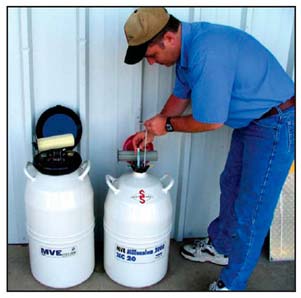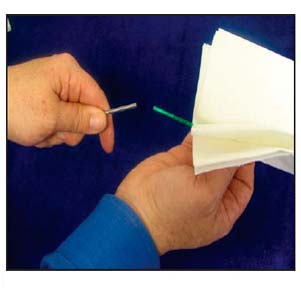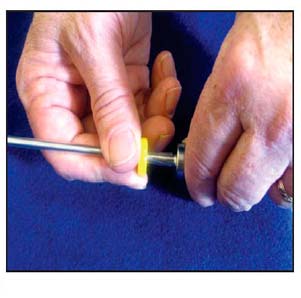 |
|
|
Translate this page in your preferred language:
|
| ARTIFICIAL INSEMINATION: |
| Back |
Artificial Insemination, a strategy for high breeding efficiency:
- In dairy cattle, there is immense potential for intensive selection amongst males (bulls) and their wider use through artificial insemination (Al) on females.
- Al is the single most important tool which has revolutionized the field of cattle breeding throughout the world.
- In natural service, a good bull could be mated with 50 -100 females per year. On the contrary, the Al with frozen semen technology has been possible use of an Al bull on about 10,000 females per year almost 100 times more utilization over the natural service.
- Al offers challenging opportunities for wider dissemination of desired inheritance per unit of time in the next generations of animals.
- The future course of large scale dairy cattle breeding in the developing countries depends on how best we adapt and adopt the Al technology to our advantage.
- The initial taboos are now disappearing, the farmer's acceptance is on the increase, but much remains to be done to avoid disappointments of the cow-owners and to achieve desired breeding goals.
- Up-gradation of local stock with males or semen of bulls of exotic dairy breeds.
- The importation of large number of breeds has proved prohibitively expensive and met with reasonable success only when maintained under good management and feeding regimes.
- The improved pure-bred exotic dairy cattle have failed to function with reasonable efficiency where feed supplies have been inadequate and health control measures unsatisfactory.
Advantages of Artificial Insemination:
- Prevention of venereal diseases.
- Indefinite preservation of genetic materials of low cost enabling wide testing and selection of bulls.
- Enhances genetic progress as best bulls are used widely nationally and internationally.
- Small scale farmers through AI can access good bulls cheaply.
- One is able to select the bull of interest.
- When handled properly, there is no chance of spread of breeding diseases.
- It is easy to control inbreeding.
- A.I. is the best method of improving the genetic make-up of local breeds because it enables semen from the very best bulls to be widely available.
- It is cost effective since the farmer does not have to rear a bull.
Loading of Insemination Gun:
- The straw is dipped in warm (37o C) water, taken out and wiped with a clean towel so that there is no water sticking on the outside.
- It is held by the Lab seal and given one or two jerks to bring air space towards the lab sealed end. The lab sealed end of the straw is cut out at right angle using the sterile scissors.
- Straw should not be cut obliquely lest the semen leaks into the sheath during insemination.
- Push back the piston of the A I gun and the straw is put into it with the factory sealed end down.
- The sheath is slipped over the gun and plastic ring is fixed over the sheath.
- The gun is now ready for use. Thawed semen should be inseminated within
30 minutes for getting good fertility.
Site of deposition of semen:
- The thawed semen is deposited in the mid cervix and frozen semen is deposited near the internal os of the cervix or the body of the uterus.
- But, before doing so, the animal should be examined as to whether it is in proper heat or not.
Special care in handling and thawing of frozen semen
- After proper identification, the desired straw should be quickly removed using a forceps or a pair of tweezers.
- While removing straw, the canister/goblet containing straws should never be raised above the frost line as the temperature within the neck of the container is higher enough to damage the motility and fertility of the semen.
- Even brief exposure is detrimental. Frozen semen straws are thawed horizontally in a bread box or any other vessel, containing water at about 37oC for 15 to 30 seconds.
- Care should be taken to avoid excessive heating of semen.
AI- Standard operating procedure:
|

Canes of semen are stored in the
canisters of specially designed liquid nitrogen tanks
refrigerators
|
 |

Bend tab up at 45 o angle
on new canes
|
 |

Use Forceps to remove straws.
|
|
 |

Cut straws 1/4 th below
lab seal at 90 o angle
|
 |

Wipe straw completely dry before
placing in pre-warmed AI gun
|
 |

Place straws in 95 o F
(35 o C) water to thaw for at least 45
seconds.
Thaw no more straws that can be
used in 15 minutes
|
|
 |

Slide sheath over AI gun |
 |

Slide sheath underneath lossened
o-ring |
 |

Lock sheath and gun together with
ssnug twist of the o-ring |
|
 |
|
|

Double sheath breeding provides both
hygenic and thermal protection |
 |

Proper seal between straw and
sheath is extremely important
|
|
|
|
| Back |
|
|
Developed by :
|
Jaspal Singh
(Ex. M.V.Sc Scholar ) |
Dr. Pranav Kumar
(Assistant Professor)
|
Amandeep Singh
(Final Year B.V.Sc & AH student) |
|
|
|
|
|
|
Scroll
|
Division of Veterinary and Animal Husbandry Extension Education
Faculty of Veterinary Sciences and Animal Husbandry, R.S. Pura, SKUAST Jammu |











